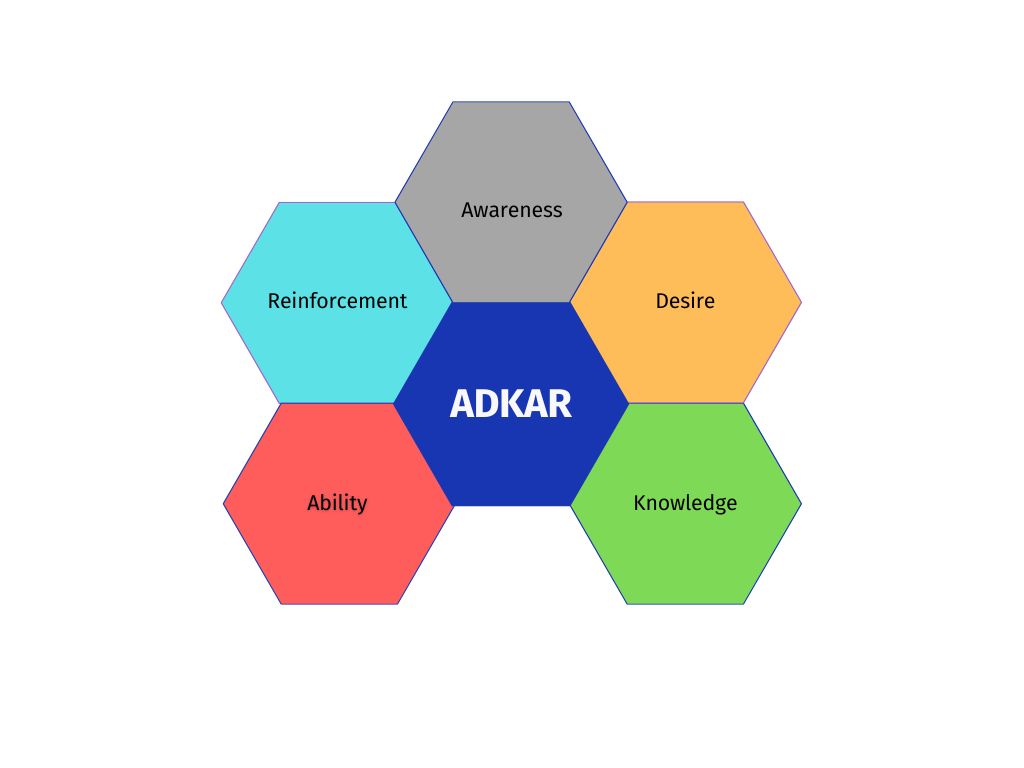In organizational life, change is inevitable, and getting the intended results requires effective change management. The well-known ADKAR change management model offers an organized approach to understanding and managing specific changes within businesses. ADKAR, which was created by Prosci, stands for Awareness, Desire, Knowledge, Ability, and Reinforcement. These are the essential components that people must complete on their own for change to be successful. This tutorial provides a thorough analysis of the ADKAR model, emphasizing its application by people managers to facilitate seamless transitions and improve organizational agility.
What is ADKAR?
The goal-oriented change management methodology known as ADKAR is designed to guide people through the many phases of change. Every stage serves as a benchmark that people must clear to effectively adjust:
Awareness: Being aware of the need for and nature of the change.
Desire: Forming a personal drive or dedication to support the shift.
Knowledge: Getting the information and abilities required to put the transformation into practice.
Ability: Showcasing the capacity to apply new behaviors or skills efficiently.
Reinforcement: Keeping the change going over time and integrating it into routine behavior.
Applying ADKAR in People Management
Understanding and the application of the ADKAR model can markedly improve people manager effectiveness since, as change leaders for teams under their watch, they are of vital importance. Below is a guide on how people managers can leverage each component of ADKAR:
Awareness
Purposeful Communication: Explain why there is a need for change and what it means to members individually or to the entire organization.
Situation Analysis: Issue market trends, customer expectations, or any other internal influences that warrant this transition.
Dealing with Concerns/Resistance: Recognize and handle employee resistance and doubts through open conversations.
Desire
Engage Employees: Involve staff in discussions and decisions concerning the changes taking place within the company.
Benefits to Emphasize: Illustrate its impact by demonstrating that it fits well into an individual’s career aspirations.
Take Ownership: Give individuals responsibility over certain activities during the process enabling them to feel part of it.
Knowledge
Training and Development Programs: Conduct training, workshops, or seminars that will enhance awareness about these changes and develop skills necessary for adopting them.
Support System: Provide access to mentors, coaches, or experts whom employees could consult for guidance.
Clarify Expectations: Explain roles, responsibilities, or processes to follow due to change.
Capability
Hands-On Support: Encourage chances that allow people to test their abilities in an enclosed setting.
Feedback Mechanisms: Offer advice and compliments as people prove that they can bring about change.
Tweak and Change: Be open to changing the way things are done by allowing for learning curves and providing sustained support in the process of moving forward.
Reinforcement
Celebrate Milestones: Acknowledge successes or significant events connected with change implementation
Continuous Communication: Regularly communicate why the change must be maintained over time and what it offers its beneficiaries
Monitor Progress: Observe changes in adoption rates, performance measures, feedback, etc. to know if there is a need for reinforcement or more support.
Benefits of Using ADKAR in Change Management
There are several advantages of using the ADKAR model when dealing with employees:
Structured Approach: It provides a well-defined process through which transitions can be managed at individual levels to prevent any critical steps from being missed during implementation.
Focus on Individual Needs: The management strategy used focuses on recognizing and addressing specific fears among team members thus making such efforts effective.
To enhance communication: enables open communication and transparency during the change process.
For measurable outcomes: it is through well-defined milestones and metrics that progress and effectiveness of the project can be measured.
To ensure sustainability: this will help in the reinforcement of new behaviors and instituting changes in the organizational culture over a long-term basis.
Challenges And Considerations
ADKAR provides a strong framework for change and people management but may face some challenges:
Resistance to Change: Addressing resistance requires empathy, patience, and proactive engagement with stakeholders.
Resource Allocation: To address training needs, ensuring adequate resources are in place in terms of development as well as reinforcement efforts is important.
Complexity of Change: However, this may mean managing multiple changes simultaneously or negotiating complex organizational structures which may require specially tailored strategies.
Conclusion
An effective way to navigate an organization’s change involves a strategic approach that puts people at the center. The ADKAR model gives managers tools to go through each stage from awareness creation and desire building through knowledge acquisition, and competence development up to the point where it is finally reinforced. When they make use of ADKAR within their change management practices, executives can create teams that are more flexible, resilient, and continuously striving for betterment. Embrace the principles of ADKAR, adapt them to your organizational context, and empower your team to embrace change as a catalyst for growth and success.
Views: 0




Leave a Reply